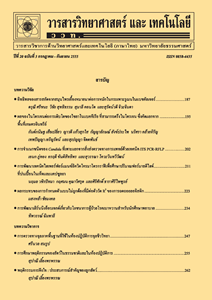การวิเคราะห์ประสิทธิภาพทางพลังงานในกระบวนการอิเล็กโทรไลเซอร์แบบออกไซด์แข็งสำหรับการผลิตไฮโดรเจน มีเทน และเมทานอล
Main Article Content
บทคัดย่อ
งานวิจัยนี้ศึกษากระบวนการอิเล็กโทรไลเซอร์แบบออกไซด์แข็งร่วมกับกระบวนการสังเคราะห์มีเทนและกระบวนการสังเคราะห์เมทานอล โดยใช้แก๊สที่ปล่อยออกจากโรงไฟฟ้าถ่านหิน ซึ่งกระบวนการดังกล่าวออกแบบและจำลองกระบวนการด้วยโปรแกรม Aspen Plus v.9.0 แบบจำลองที่สร้างขึ้นจะนำมาใช้ในการศึกษาสภาวะการดำเนินงานที่เหมาะสมที่ทำให้ผลิตภัณฑ์และประสิทธิภาพทางพลังงานมีค่ามากที่สุด โดยศึกษาอิทธิพลของตัวแปรที่มีผลต่อทั้งสามกระบวนการ ได้แก่ อุณหภูมิและความดันของกระบวนการอิเล็กโทรไลเซอร์แบบออกไซด์แข็ง (550-1,000 ºC, 1-30 บาร์) อุณหภูมิและความดันของกระบวนการสังเคราะห์มีเทน (200-600 ºC, 1-100 บาร์) และอุณหภูมิและความดันของกระบวนการสังเคราะห์เมทานอล (140-280 ºC, 15-100 บาร์) ร่วมกับการวิเคราะห์ประสิทธิภาพทางพลังงาน ผลการศึกษาพบว่าสภาวะการดำเนินงานที่เหมาะสมที่ผลิตแก๊สไฮโดรเจนได้มากที่สุดของกระบวนการอิเล็กโทรไลเซอร์แบบออกไซด์แข็ง คือ อุณหภูมิและความดันของกระบวนการ 800 องศาเซลเซียส และ 1 บาร์ โดยประสิทธิภาพทางพลังงานมีค่า 14.95 % สภาวะการดำเนินงานที่เหมาะสมของกระบวนการสังเคราะห์มีเทน คือ อุณหภูมิและความดันของกระบวนการ 200 องศาเซลเซียส และ 1 บาร์ โดยประสิทธิภาพทางพลังงานมีค่า 69.97 % และสภาวะการดำเนินงานที่เหมาะสมของกระบวนการสังเคราะห์เมทานอล คือ อุณหภูมิและความดันของกระบวนการ 160 องศาเซลเซียส และ 100 บาร์ โดยประสิทธิภาพทางพลังงานมีค่า 75.42 %
Article Details
เอกสารอ้างอิง
Parigi, D., Giglio, E., Soto, A. and Santarelli, M., 2019, Power-to-fuels through carbon dioxide re-utilization and high temperature electrolysis: A technical and economical comparison between synthetic methanol and methane, J. Clean. Prod. 226: 679-691.
Bozzano, G. and Manenti, F., 2016, Efficient methanol synthesis: Perspectives, technologies and optimization strategies, Prog. Energy Combust. Sci. 56: 71-105.
Andika, R., Nandiyanto, A.B., Putra, Z.A., Bilad, M.R., Kim, Y., Yun, C.M. and Lee, M., 2018, Co-electrolysis for power-to-methanol applications, Renew. Sustain. Energy Rev. 95: 227-241.
Redissi, Y. and Bouallou, C., 2013, Valorization of carbon dioxide by co-electrolysis of CO2/H2O at high temperature for syngas production, Energy Proc. 37: 6667–6678.
Van-Dal, E.S. and Bouallou, C., 2013, Design and simulation of a methanol production plant from CO2 hydrogenation, J. Clean. Prod. 57: 38-45.
Sharifian, S. and Harasek, M., 2015, Simulation of COX Methanation Reactor for the Production of Natural Gas, Chem. Eng. Transact. 45: 1003-1008.
Nattawut, W. and Amornchai, A., 2014, Electrolysis for hydrogen production, Technol. Promot. Innomag Magazine 237: 45-48. (in Thai)
Wang, L., Rao, M., Diethelm, S., Lin, T., Zhang, H., Hagen, A. and van Herle, J., 2019, Power-to-methane via co-electrolysis of H2O and CO2: The effects of pressurized operation and internal methanation, Appl. Energy 250: 1432-1445.
Stempien, J.P., Ding, O.L., Sun, Q. and Chan, S.H., 2012, Energy and exergy analysis of solid oxide electrolyser cell (SOEC) working as a CO2 mitigation device, Int. J. Hydrogen Energy 37: 14518-14527.
Pozzo, M., Lanzin, A. and Santarelli, M., 2015, Enhanced biomass-to-liquid (BTL) conversion process through high tempera ture co-electrolysis in a solid oxide electrolysis cell (SOEC), Fuel 145: 39-49.
Tinoco, R.R., Farran, M., Bouallou, C., Aupretre, F., Valentin, S., Millet, P. and Ngameni, J.R., 2016, Investigation of power-to-methanol processes coupling electrolytic hydrogen production and catalytic CO2 reduction, Int. J. Hydrogen Energy 41: 4546-4559.
Li, W., Wang, H., Shi, Y. and Cai, N., 2013, Performance and methane production characteristics of H2O-CO2 co-electrolysis in solid oxide electrolysis cells, Int. J. Hydrogen Energy 38: 11104-11109.
Er-rbib, H. and Bouallou, C., 2013, Modelling and simulation of methanation catalytic reactor for renewable electricity storage. Chem. Eng. Transact 35: 541-546.
Porubova, J., Bazbauers, G. and Markova, D., 2011, Modeling of the adiabatic and isothermal methanation process, Sci. J. Riga Tech. Univer. 6: 79-84.
Kim, W.S., Yang, D.R., Moon, D.J. and Ahn, B.S., 2014, The process design and simulation for the methanol production on the FPSO (floating production, storage and off-loading) system, Chem. Eng. Res. Design 92: 931-940.
Rujiroj, T., Rujira, J., Tarawipa, P., Weerawat, P. and Kamonrat, L., 2018, Kinetic modeling and simulation of bio-methanol process from biogas by using aspen plus, MATEC Web Conf. 192: 3030-3034.
Mignard, D. and Pritchard, C., 2008, On the use of electrolytic hydrogen from variable renewable energies for the enhanced conversion of biomass to fuels, Chem. Eng. Res. Design 86: 473-487.
Lonis, F., Tola, V. and Cau, G., 2019, Renewable methanol production and use through reversible solid oxide cells and recycled CO2 hydrogenation, Fuel 246: 500-515.
Kang, W.R. and Lee, K.B., 2013, Effect of operating parameters on methanation reaction for the production of synthetic natural gas, Korean J. Chem. Eng. 30: 1386-1394.
Lücking, L.E., 2017, Methanol Production from Syngas: Process Modelling and Design Utilizing Biomass Gasification and Integrating Hydrogen Supply, Delft University of Technology, Mekelweg.
Puig-Gamero, M., Argudo-Santamaria, J., Valverde, J.L., Sánchez, P. and Sanchez-Silva, L., 2018, Three integrated process simulation using aspen plus®: Pine gasification, syngas cleaning and methanol synthesis, Energy Convers Manag. 177: 416-427.


